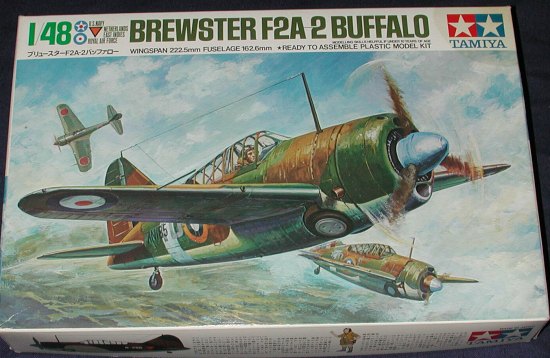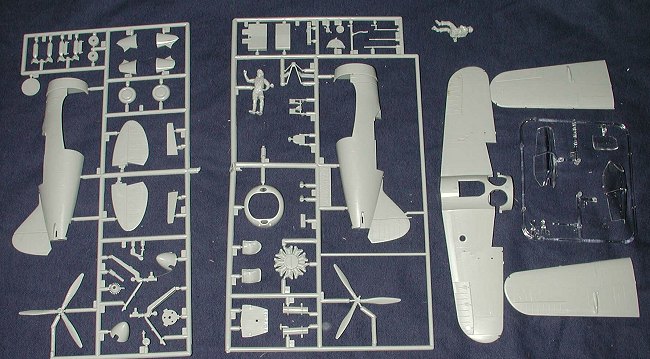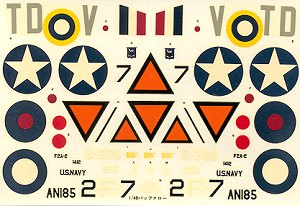
|
KIT: |
Tamiya 1/48 F2A-2 Buffalo |
|
KIT # |
MA 119 |
|
PRICE: |
? |
|
DECALS: |
Three aircraft |
|
REVIEWER: |
|
|
NOTES: |
This boxing long out of production |

|
HISTORY |
It is less well known that the Buffalo actually served with distinction with the Finnish Air Force. While poorly matched against the highly maneuverable Zero, it was a better match-up against Soviet Fighters. Other countries to fly the Buffalo were the British and the Dutch. Both used them against attacking Japanese forces during late 1941 and early 1942 in Burma and the Dutch East Indies. While they were outclassed by the Ki-43 and A6M2 fighters, they did do a credible job against Japanese bombers and the earlier Ki-27 fighters. Several of the type were captured and tested by the Japanese who found their lack of maneuverability (at least compared to Japanese fighers) to be a detriment.
With a top speed of only about 300mph the Buffalo was a stop-gap
fighter for the Allies in the Pacific. Armed with a variety of weapons,
ranging from 1x.50 cal and 1x7.62mm in the early models to 4x.50cal in the
later version, the Buffalo was no powerhouse of firepower. Outclassed by the
A6M Zero, the F2A soon earned a reputation among those Marine pilots who
flew it as a virtual deathtrap. It was soon turned over to training commands,
far from where it could be shot at, where it served as an advanced fighter
trainer. Most were gone by 1943. 502 Buffalos were built.
|
THE KIT |

When Tamiya finally figured out that 1/50 wasn't going to be the standard scale for models of this size, the Buffalo was one of the first kits (along with the Lancaster) that it molded in this 'new' scale. The kit is in many ways, quite modern with engraved panel lines, cockpit and wheel well detailing, and optional parts. This particular kit is free from flash and sink marks. I can't say the same about ejector pin marks as they are to be found on a number of smaller bits. None of them seem to be too difficult to remove.
Unlike the more current boxing, which is for only an F2A-2, this one allows a
B-339 and an RAF Buffalo to be built. As such, the kit comes with an additional
prop and spinner, pilots seat, tail cone, and canopy to allow these other
aircraft to be built. Just why Tamiya decided to eliminate these features from
the current kit is a mystery, but it does allow for the earlier boxings to be
more highly sought. The kit also includes two figures, one seated and the other
standing. 
The instructions are entirely in Japanese with no English translations at all. However, they are are well done so should not be a problem, except for color info. There are markings for three aircraft provided. One is a USN 'yellow wing' F2A-2 from 1940 with a blue cowling and a yellow tail. Next is a Dutch version in a green/brown upper with either light grey or silver undersides. The RAF version is from what appears to be 453 Sq in defense of Singapore in 1941/42. It is in the usual RAF colors of Dark Earth/Dark Green over white/black with the black on the left side. A very nice color painting and decal guide is included in the box. Though the decals are quite old, they do appear to be still useful. One thing about Japanese decals is that they can be good for several decades!
|
CONCLUSIONS |
This kit makes into a very nice model. The current boxing is still easily found, but those wanting to do a non-US version will want to seek out the earlier boxing. It can be found at swap meets for around $15-20.
If you would like your product reviewed fairly and quickly by a site that has 200,000 visitors a month, please contact me or see other details in the Note to Contributors.